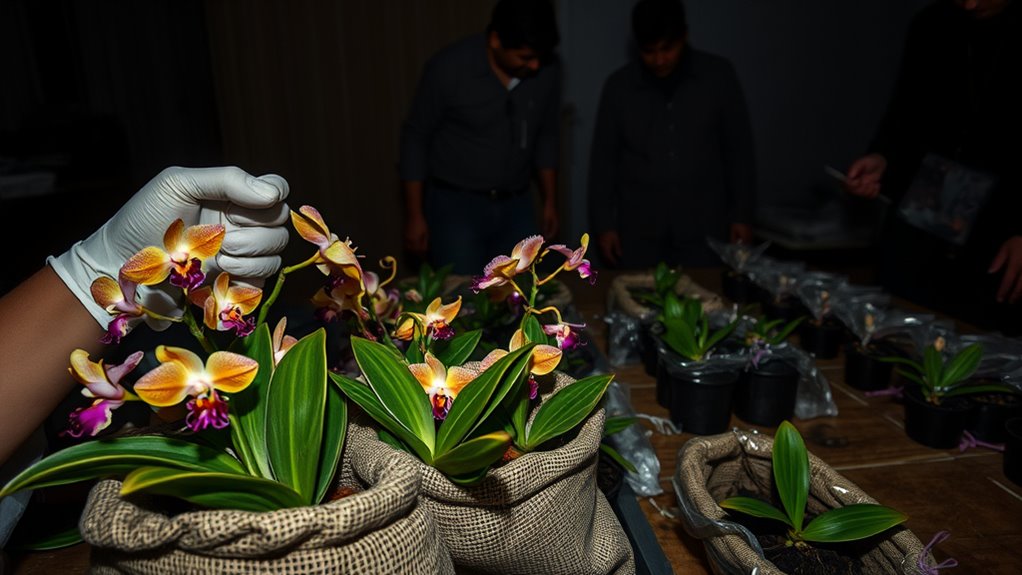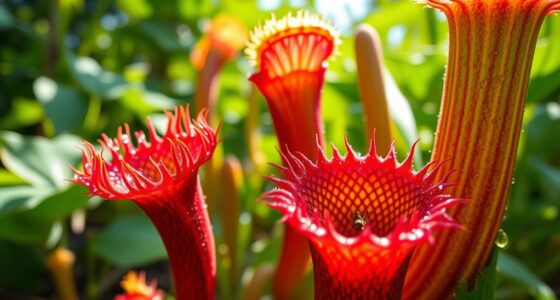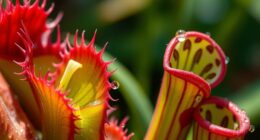Illegal plant poaching and smuggling threaten biodiversity by removing rare species from their natural habitats, weakening ecosystems and pushing many toward extinction. Criminal networks operate across borders, using deception and forged documents to evade authorities. Enforcement efforts face challenges like sophisticated trafficking routes and limited resources. Raising awareness and strict legal measures play essential roles in combating these crimes. If you keep exploring, you’ll discover how conservation strategies attempt to protect our world’s precious plant species.
Key Takeaways
- Plant poaching involves illegal harvesting of rare and endangered species, threatening biodiversity and ecosystems worldwide.
- Smugglers use deception, forged documents, and clandestine routes to evade law enforcement.
- International regulations like CITES aim to control illegal plant trade, but enforcement remains challenging across borders.
- Awareness and education initiatives are crucial to reduce demand and support conservation efforts.
- Strong legal enforcement, habitat protection, and global cooperation are vital to combat plant smuggling effectively.

Have you ever wondered how illegal plant trade threatens biodiversity? It’s a pressing issue that endangers countless species and disrupts delicate ecosystems worldwide. Plants aren’t just decorative; they play essential roles in maintaining ecological balance, supporting wildlife, and stabilizing environments. When poachers and smugglers harvest rare and endangered plants illegally, they push these species closer to extinction. To combat this, conservation strategies are being implemented to protect vulnerable plants, but without strong legal enforcement, these efforts often fall short. Effective laws and strict penalties are fundamental to deter illegal activities, ensuring that rare plants aren’t stolen from their natural habitats and sold on the black market. You might not see the immediate impact, but each illegal collection chips away at biodiversity, weakening ecosystems that rely on these plants to thrive. Strengthening legal enforcement and promoting awareness are crucial steps in tackling this issue.
Legal enforcement acts as a critical line of defense against plant poaching and smuggling. Authorities need to crack down on illegal trade networks through vigilant monitoring, raids, and harsher punishments for offenders. When laws are enforced consistently and transparently, it sends a clear message that illegal plant trade won’t be tolerated. This discourages poachers from risking their freedom and livelihoods. Additionally, international cooperation is essential, as many plant smuggling rings operate across borders. Agencies like CITES (the Convention on International Trade in Endangered Species of Wild Fauna and Flora) work to regulate and control the trade of protected plants, but enforcement depends on the commitment of individual countries. You can imagine how difficult it is to track every illegal shipment, especially when traffickers use deception, forged documents, or clandestine routes. That’s why strengthening legal enforcement measures and increasing penalties can make a real difference.
Beyond laws, raising awareness about the importance of conserving native flora is indispensable. Educating local communities, traders, and consumers about the ecological and moral implications of illegal plant trade helps build support for enforcement efforts. When people understand that buying rare plants fuels illegal smuggling, they’re less likely to participate. Support from conservation organizations can also provide resources for monitoring at-risk areas and training law enforcement personnel. The fight against plant poaching isn’t easy, but with comprehensive conservation strategies and unwavering legal enforcement, you can help protect the world’s invaluable plant diversity. Every effort counts in preserving the natural heritage for future generations and ensuring that these essential species continue to thrive in their native habitats.
Frequently Asked Questions
How Do Criminals Smuggle Rare Plants Across Borders Unnoticed?
Criminals smuggle rare plants across borders by using hidden routes, often avoiding main checkpoints. They create fake documentation that looks legitimate, tricking officials into allowing the plants through. Sometimes, they hide plants inside other objects or use packaging designed to deceive inspection systems. By blending these tactics, they reduce the risk of detection, making it easier to move illegal plants unnoticed and continue their black market trade.
What Are the Most Targeted Plant Species by Poachers?
Imagine you’re in a bustling market, where endangered orchids and exotic succulents are the most targeted species by poachers. These plants fetch high prices on the black market, making them prime targets. You’d find illegal collectors sneaking out rare orchids from rainforests and smuggling exotic succulents from deserts. Their rarity and high demand drive illegal activities, putting these species at great risk of extinction.
How Can Consumers Verify the Legality of Rare Plants?
You can verify the legality of rare plants by checking for plant conservation labels and legal certifications from reputable sources. Always buy from trusted nurseries and dealers who provide documentation like CITES permits or other official papers. Research the plant’s origin and ask for proof of legal collection or propagation. Being diligent helps prevent supporting illegal poaching, ensuring you promote sustainable practices and protect endangered species.
What Impact Does Plant Smuggling Have on Ecosystems?
Plant smuggling is like ripping pages from a crucial book—disrupting the story of ecosystems. It causes ecosystem disruption and biodiversity loss, weakening the delicate balance that sustains life. When rare plants are removed illegally, it harms native species, reduces genetic diversity, and destabilizes habitats. Your awareness and actions help protect these ecosystems, ensuring they remain resilient and vibrant for future generations.
Are There International Laws Specifically Targeting Plant Trafficking?
Yes, there are international laws targeting plant trafficking, and you should be aware of them. You can find plant trade regulations under agreements like CITES, which aims to control the illegal trade of endangered plants. Legal enforcement plays an essential role in protecting plant species, so understanding and adhering to these regulations helps prevent illegal smuggling and supports conservation efforts worldwide. Stay informed and compliant to make a positive impact.
Conclusion
You might be surprised to learn that over 1,000 plant species are threatened with extinction due to illegal poaching and smuggling every year. This underground trade not only endangers rare plants but also disrupts ecosystems worldwide. By staying informed and supporting conservation efforts, you can help combat this illegal activity. Remember, every small action counts in protecting our planet’s incredible botanical diversity from being lost forever.










